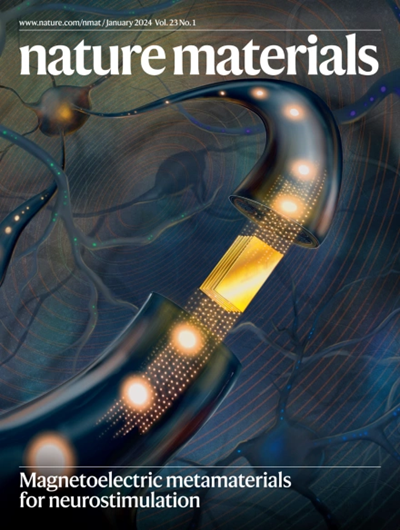Stiff and self-healing hydrogels by polymer entanglements in co-planar nanoconfinement
IF 37.2
1区 材料科学
Q1 CHEMISTRY, PHYSICAL
引用次数: 0
Abstract
Many biological tissues are mechanically strong and stiff but can still heal from damage. By contrast, synthetic hydrogels have not shown comparable combinations of properties, as current stiffening approaches inevitably suppress the required chain/bond dynamics for self-healing. Here we show a stiff and self-healing hydrogel with a modulus of 50 MPa and tensile strength up to 4.2 MPa by polymer entanglements in co-planar nanoconfinement. This is realized by polymerizing a highly concentrated monomer solution within a scaffold of fully delaminated synthetic hectorite nanosheets, shear oriented into a macroscopic monodomain. The resultant physical gels show self-healing efficiency up to 100% despite the high modulus, and high adhesion shear strength on a broad range of substrates. This nanoconfinement approach allows the incorporation of novel functionalities by embedding colloidal materials such as MXenes and can be generalized to other polymers and solvents to fabricate stiff and self-healing gels for soft robotics, additive manufacturing and biomedical applications. Mechanical stiffness and self-healing properties are difficult to combine in synthetic hydrogels. Using polymer entanglements in co-planar nanoconfinement, stiff and self-healing hydrogels are fabricated, with applications in biology and engineering.


共面纳米约束下聚合物缠结的刚性和自愈水凝胶
许多生物组织在机械上坚固而坚硬,但仍然可以从损伤中愈合。相比之下,合成水凝胶并没有表现出类似的性能组合,因为目前的强化方法不可避免地抑制了自愈所需的链/键动力学。在共面纳米约束下,通过聚合物缠结,我们展示了一种刚性和自愈的水凝胶,其模量为50 MPa,拉伸强度高达4.2 MPa。这是通过将高度浓缩的单体溶液聚合在完全分层的合成赫克托石纳米片支架内,剪切定向成宏观单畴来实现的。所得到的物理凝胶尽管具有高模量,但其自愈效率高达100%,并且在广泛的基材上具有高粘附剪切强度。这种纳米约束方法可以通过嵌入胶体材料(如MXenes)来整合新功能,并且可以推广到其他聚合物和溶剂中,以制造用于软机器人、增材制造和生物医学应用的坚硬和自愈凝胶。
本文章由计算机程序翻译,如有差异,请以英文原文为准。
求助全文
约1分钟内获得全文
求助全文
来源期刊

Nature Materials
工程技术-材料科学:综合
CiteScore
62.20
自引率
0.70%
发文量
221
审稿时长
3.2 months
期刊介绍:
Nature Materials is a monthly multi-disciplinary journal aimed at bringing together cutting-edge research across the entire spectrum of materials science and engineering. It covers all applied and fundamental aspects of the synthesis/processing, structure/composition, properties, and performance of materials. The journal recognizes that materials research has an increasing impact on classical disciplines such as physics, chemistry, and biology.
Additionally, Nature Materials provides a forum for the development of a common identity among materials scientists and encourages interdisciplinary collaboration. It takes an integrated and balanced approach to all areas of materials research, fostering the exchange of ideas between scientists involved in different disciplines.
Nature Materials is an invaluable resource for scientists in academia and industry who are active in discovering and developing materials and materials-related concepts. It offers engaging and informative papers of exceptional significance and quality, with the aim of influencing the development of society in the future.
 求助内容:
求助内容: 应助结果提醒方式:
应助结果提醒方式:


